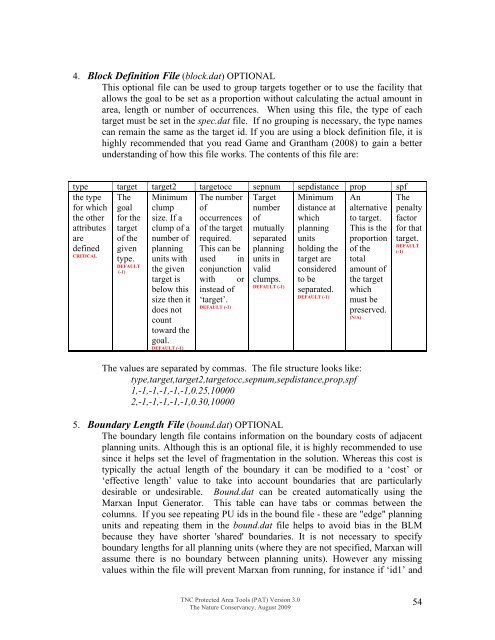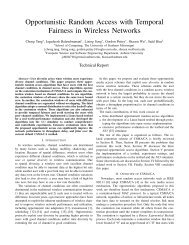Download the Tutorial
Download the Tutorial
Download the Tutorial
You also want an ePaper? Increase the reach of your titles
YUMPU automatically turns print PDFs into web optimized ePapers that Google loves.
4. Block Definition File (block.dat) OPTIONALThis optional file can be used to group targets toge<strong>the</strong>r or to use <strong>the</strong> facility thatallows <strong>the</strong> goal to be set as a proportion without calculating <strong>the</strong> actual amount inarea, length or number of occurrences. When using this file, <strong>the</strong> type of eachtarget must be set in <strong>the</strong> spec.dat file. If no grouping is necessary, <strong>the</strong> type namescan remain <strong>the</strong> same as <strong>the</strong> target id. If you are using a block definition file, it ishighly recommended that you read Game and Grantham (2008) to gain a betterunderstanding of how this file works. The contents of this file are:type targe t target2 targetocc sepnum sepdistance prop spf<strong>the</strong> typeTheMini mum The number Target MinimumAn Thefor whichgoal clump ofnumber distance at alternativepenalty<strong>the</strong> o<strong>the</strong>rfor <strong>the</strong> size. If a occurrences of which to target. factorattributestarget clump of a of <strong>the</strong> target mutually planning This is <strong>the</strong> for thatare of <strong>the</strong> number of required. separated units proportiontarget.DEFAULTdefined given planningThis can be planning holding <strong>the</strong> of <strong>the</strong>(-1)CRITICALtype. units with used in units in target are totalDEFAULT(-1) <strong>the</strong> given conjunction valid considered amount oftarget is with or clumps. to be <strong>the</strong> targetDEFAULT (-1)below this instead ofseparated. whichDEFAULT (-1)size <strong>the</strong>n it ‘target’.must beDEFAULT (-1)does notpreserved.count(N/A)toward <strong>the</strong>goal.DEFAULT (-1)The values are separated by commas. The file structure looks like:type,target,target2,targetocc,sepnum,sepdistance,prop,spf1,-1,-1,-1,-1,-1,0.25,100002,-1,-1,-1,-1,-1,0.30,100005. Boundary Length File (bound.dat) OPTIONALThe boundary length file contains information on <strong>the</strong> boundary costs of adjacentplanning units. Although this is an optional file, it is highly recommended to usesince it helps set <strong>the</strong> level of fragmentation in <strong>the</strong> solution. Whereas this cost istypically <strong>the</strong> actual length of <strong>the</strong> boundary it can be modified to a ‘cost’ or‘effective length’ value to takeinto account boundaries that are particularlydesirable or undesirable. Bound.dat can be created automatically using <strong>the</strong>Marxan Input Generator. This table can have tabs or commas between <strong>the</strong>columns. If you see repeating PU ids in <strong>the</strong> bound file - <strong>the</strong>se are "edge" planningunits and repeating <strong>the</strong>m in <strong>the</strong> bound.dat file helps to avoid bias in <strong>the</strong> BLMbecause <strong>the</strong>y have shorter 'shared' boundaries. It is not necessary to specifyboundary lengths for all planning units (where <strong>the</strong>y are not specified, Marxan willassume <strong>the</strong>re is no boundary between planning units). However any missingvalues within <strong>the</strong> file will prevent Marxan from running, for instance if ‘id1’ andTNC Protected Area Tools (PAT) Version 3.0The Nature Conservancy, August 200954
















